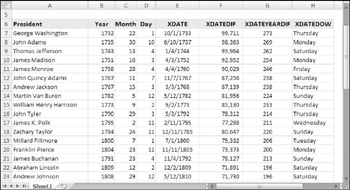Date Functions
Chapter 6 presents a number of useful Excel functions and formulas for calculating dates, times, and time periods by manipulating date and time serial values. This section presents additional functions that deal with dates.
| On the CD | The companion CD-ROM contains a workbook, |
Calculating the Next Monday
The following NEXTMONDAY function accepts a date argument and returns the date of the following Monday:
Function NEXTMONDAY(d As Date) As Date NEXTMONDAY = d + 8 - WeekDay(d, vbMonday) End Function
This function uses the VBA WeekDay function, which returns an integer that represents the day of the week for a date (1 = Sunday, 2 = Monday, and so on). It also uses a predefined constant, vbMonday.
The following formula returns 12/31/2007, which is the first Monday after Christmas Day, 2007 (which is a Tuesday):
=NEXTMONDAY(DATE(2006,12,25))
| Note | The function returns a date serial number. You will need to change the number format of the cell to display this serial number as an actual date. |
If the argument passed to the NEXTMONDAY function is a Monday, the function will return the following Monday. If you prefer the function to return the same Monday, use this modified version:
Function NEXTMONDAY2(d As Date) As Date If WeekDay(d) = 2 Then NEXTMONDAY2 = d Else NEXTMONDAY2 = d + 8 - WeekDay(d, vbMonday) End If End Function
Calculating the Next Day of the Week
The following NEXTDAY function is a variation on the NEXTMONDAY function. This function accepts two arguments: A date and an integer between 1 and 7 that represents a day of the week (1 = Sunday, 2 = Monday, and so on). The NEXTDAY function returns the date for the next specified day of the week.
Function NEXTDAY(d As Date, day As Integer) As Variant ' Returns the next specified day ' Make sure day is between 1 and 7 If day < 1 Or day > 7 Then NEXTDAY = CVErr(xlErrNA) Else NEXTDAY = d + 8 - WeekDay(d, day) End If End Function
The NEXTDAY function uses an If statement to ensure that the day argument is valid (that is, between 1 and 7). If the day argument is not valid, the function returns #N/A. Because the function can return a value other than a date, it is declared as type Variant.
Which Week of the Month?
The following MONTHWEEK function returns an integer that corresponds to the week of the month for a date:
Function MONTHWEEK(d As Date) As Variant ' Returns the week of the month for a date Dim FirstDay As Integer ' Check for valid date argument If Not IsDate(d) Then MONTHWEEK = CVErr(xlErrNA) Exit Function End If ' Get first day of the month FirstDay = WeekDay(DateSerial(Year(d), Month(d), 1)) ' Calculate the week number MONTHWEEK = Application.RoundUp((FirstDay + day(d) - 1) / 7, 0) End Function
Working with Dates Before 1900
Many users are surprised to discover that Excel can't work with dates prior to the year 1900. To correct this deficiency, I created a series of extended date functions. These functions enable you to work with dates in the years 0100 through 9999.
The extended date functions are
-
XDATE(y,m,d,fmt): Returns a date for a given year, month, and day. As an option, you can provide a date formatting string.
-
XDATEADD(xdate1,days,fmt): Adds a specified number of days to a date. As an option, you can provide a date formatting string.
-
XDATEDIF(xdate1,xdate2): Returns the number of days between two dates.
-
XDATEYEARDIF(xdate1,xdate2): Returns the number of full years between two dates (useful for calculating ages).
-
XDATEYEAR(xdate1): Returns the year of a date.
-
XDATEMONTH(xdate1): Returns the month of a date.
-
XDATEDAY(xdate1): Returns the day of a date.
-
XDATEDOW(xdate1): Returns the day of the week of a date (as an integer between 1 and 7).
Figure 25-5 shows a workbook that uses a few of these functions.

Figure 25-5: Examples of the extended date function.
| On the CD | These functions are available on the companion CD-ROM, in a file named |
| Caution | The extended date functions don't make any adjustments for changes made to the calendar in 1582. Consequently, working with dates prior to October 15, 1582, may not yield correct results. |
EAN: 2147483647
Pages: 212